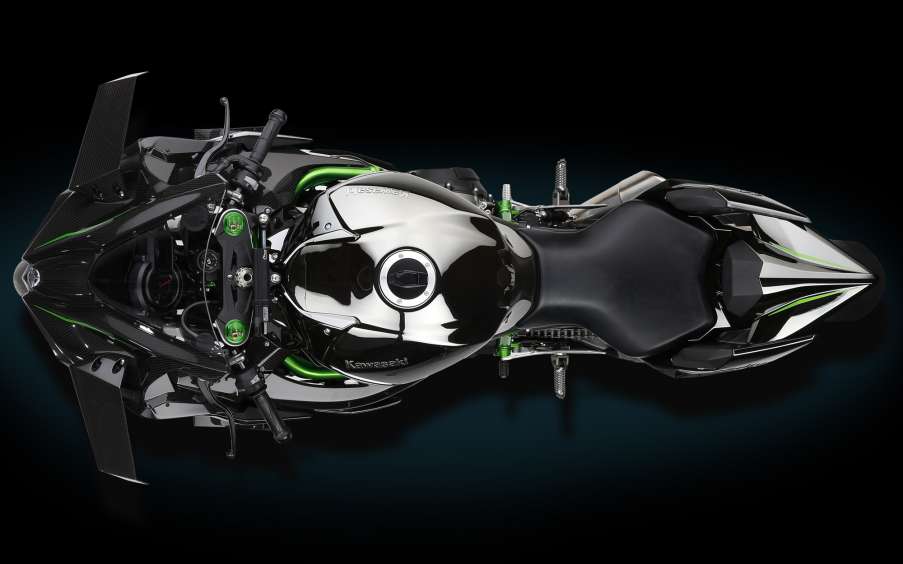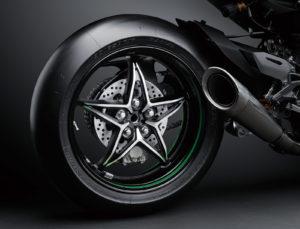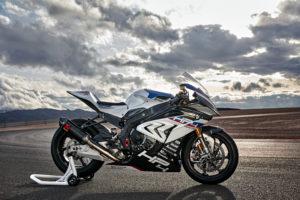REPUBLISHED FROM 2017
IT’S the heavyweight motorcycle championship bout of all-time, and it’s coming soon.
In the left corner, we have Japan’s stunning racetrack-only Kawasaki H2R: released in 2015 to a gobsmacked motorcycle industry starved of absurd-but-thrilling performance figures ever since a bunch of European kill-joy lawmakers poured ice water over the previously unhindered superbike performance war.
Soon to arrive in the right corner, Germany’s new BMW HP4Race: the German counterpunch to the H2R which confirms that the 300km/h truce is over and high-speed global hostilities may resume, albeit in a form that denies highway blasting.

Make no mistake, the mad-performance war is back. Japanese and European manufacturers of top shelf superbikes have been champing at the bit to find a way around the voluntary but through-gritted-teeth gentleman’s agreement that production bikes be limited to a 300km/h top speed.
That agreement was put in place 17 years ago, after the 1999 Suzuki Hayabusa hit 312km/h. Several European countries threatened to stop importing bikes unless the performance war ended. The manufacturers couldn’t afford to call their bluff, and the biking public have been denied the sport of watching the speed battle ever since.

When Kawasaki unveiled the H2R, it had found the loophole. Hey, these are race bikes. They’re meant to go fast. The ‘agreement’ does not apply.
The H2R and the HP4Race are racetrack variants of the H2 and HP4 both of which, like the Ducati 1299 Superleggera, were already hyper-fast and colossa-powerful sports bikes perfectly capable of being used as race bikes anyway. But now, with the ‘R’ and ‘Race’ incarnations, you don’t even have to take off the indicators. What you do need is a very deep wallet or a first-name, how’re-the-kids, do-ya-wanna-borrow-my-wife relationship with your bank manager.

And first, you’ll need to find one. Kawasaki Australia’s PR, Media & Race Support Coordinator, Milo Dokmanovic, told The Bike Shed Times that the H2R was no longer being distributed in Australia, so if you want one you’ll need to go hunting. So we did. A stroll around the web confirmed the H2R is still being manufactured, so presumably you could track one down and have it imported for another wad (or two) of hundred dollar notes. The only H2R we found for sale in Australia is a zero-miles private sale in South Australia. The seller wants “offers above $78,000” for it.
The HP4Race isn’t available yet, but Samael Louwen at Auto Classic BMW in Victoria Park tells us it’s on the way to Perth.
“We certainly will be selling the HP4 Race in Australia,” Samael told us “for a price of $110,000 plus GST. They will be available in the final quarter of this year but are in very limited numbers (10 only). We will take orders from now with a $25,000 deposit.”

With that $100k+ price tag, the screaming Beemer is in the same cost category as Ducati’s Superleggera which, interestingly, has precisely the same power output but weighs an extra 10kg. Of course, the Duke has road-going legalities, but it also has a speed limiter.
Still interested? Of course you are. Hey, there’s a tax refund on the way in a month or two.
So what do we get for half-a-little-house money?

The H2R Kawasaki, named after the H2 Kawasaki from 1972, will pull 400km/h and reaches the first 100km/h in about 2.5 seconds. And that’s not just brochure talk. Kawasaki convinced authorities in Turkey to use the new 2.7km Osman Gazi suspension bridge, about 50km southeast of Istanbul, so Red Bull-Kawasaki World Supersport rider Kenan Sofuoglu could give the 310-horsepower supercharged H2R a good fang. It took him just 26 seconds to hit 400.
(The 1972 H2 Mach IV was only half the bike. It ran a triple-cylinder 750cc two stroke engine that was good for 0-100km/h in 5 seconds, a top speed of 202km/h and 74 horsepower. It’s nearest horsepower competitor was Triumph’s three-cylinder four stroke Trident with less than 60hp. The Mach IV handled like a piece of warm-and-wet spaghetti, and pulled wheelstands whether you liked it or not. And by the standards of the day it was unthinkably fast.)


BMW’s HP4Race doesn’t have the Kawasaki’s supercharger, and its raw numbers are a fair way south. But 215 horsepower should be, let’s say, adequate on a bike that weighs about 171kg plus an iPhone, wet.
Its feather weight comes from widespread use of carbon fibre; not just the pretty bits, but also the wheels and frame. Yep, the frame is carbon fibre — just like the TaylorMade driver in your brother-in-law’s golf kit — and weighs less than 8kg.
Other clever stuff includes traction control, programmable engine braking, wheelie control, launch control, and a pit lane limiter so you don’t lose points for riding too fast through the pits. Very handy at BarbaCollie Raceway.




SPECIFICATIONS
2017 Kawasaki H2R

SPECIFICATIONS
2017 BMW HP4RACE

Don’t have a spare $100k?
Don’t worry. We have plenty of big fast sports bikes listed for sale. See them at Bikes For Sale.





